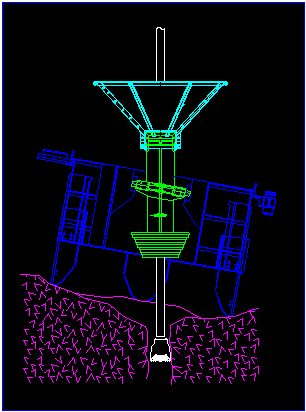

Hard Rock Base
Description
The Hard Rock Base (HRB) is designed to focus the direction of the drill bit into hard irregular seafloor surfaces otherwise undrillable.
Specifications
- Dry weight (unballasted) = 41,400 lbs
- Submerged weight (unballasted) = 36,000 lbs
- Approximate submerged weight (ballasted) = 125,000 lbs
- Reentry cone diameter = 8 ft
- Reentry cone uprighting moment factor of safety = 2.5
- Factor of safety against leg bolt shear = 19
- Maximum design tilt (into side) = 25°
- Maximum design tilt (into corner) = 30°
- Maximum recommended operational limit = 20°
- Leg extension beneath base = 3 ft

Problems Associated with Landing an HRB
- Seafloor slope
- Seafloor stability
- Sediment thickness
- Sufficient area suitable to land base
- Weather/sea state/water depth conditions
- BP471 not suitable or efficient as a survey vessel
- Very rugged canyonous topography
Design/Deployment Capabilities
- Can be set on hard bare rock outcrops with flat or irregular topography on slopes less than or equal to 20°
- Requires sediment cover to be less than 3 ft
- Recoverable/Redeployable
- Can be relocated on the seafloor
Considerations of Using an HRB
- Permanent/long term reentry site
- 1, 2, or 3 casing strings required
- Time required to under ream or hole open
- Time to locate/position/run HRB
- Adequate survey of seafloor deployment area
- Space availability on BP471 for support hardware of HRB/casing (when considering multiple HRB deployments)
Input Data for Landing an HRB
- Mechanical tilt indicator (Bullseye)
- maximum range = 23.5°
- Electronic tilt beacon (Note 1) = 40°
- Mesotech (Note 2) = Limited
- Visual form V.I.T. (Note 2) = Limited
Notes
Electronic Tilt Beacons have experienced some freezing and/or erratic behavior due to rugged reentry cone shielding or topography.
Need experience to interpret results/data.